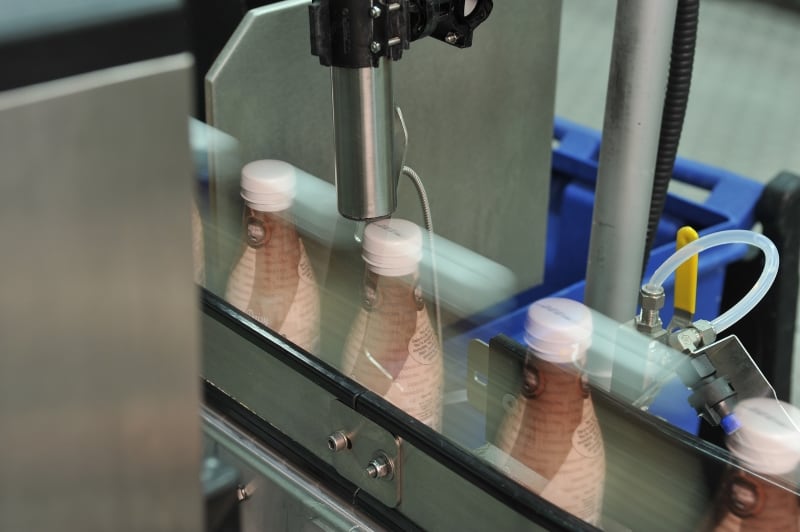Uptime is critical, and with product flavors and variety increasing all the time, increased changeovers are adding further complexity.
Add to that the fact that packaging designs are changing and materials varying – from PET bottles and paperboard to flexible and metalized films – and the need to include ever more information in terms of coding and marking, and it becomes even more complex.
Retailers, manufacturers and consumers continue to rely on ‘best by’ and ‘sell by’ dates to ensure their products are safe to sell and consume, therefore these codes must be clear, accurate and consistent when printed onto dairy packaging.
For dairy products, in particular, these codes provide critical product freshness information to consumers at the point of sale. Some dairy producers have also begun to provide additional variable information, such as product provenance down to the individual farm level.
Code placement
The placement of these codes is a key consideration for dairy manufacturers. Expiration dates, for example, are often printed directly onto a product’s seal or lid, which can be easily removed and discarded by the consumer.

In response to this, many dairy manufacturers are taking the decision to move the code location to the main portion of the product’s packaging. This presents a number of challenges in itself.
Firstly, in order to not impede production, these changes require some flexibility from coding equipment in order to print codes in constrained spaces or in various orientations.
Secondly, with coding being placed onto the main body of the container, there is some concern as to how this will affect the design of the packaging itself in terms of shelf appeal.
Lastly, any changes made must take into consideration the need for code clarity and maintaining high line speeds.
Code expertise
In order to ensure each of these concerns is met, it is highly advisable to work in partnership with an expert provider of coding and marking solutions. Careful, expert evaluation is required when relocating codes and it can even be possible to go into the finer details of packaging design to ensure the proposed codes do not detract from a product’s shelf appeal.
There are a number of printing technologies available for the dairy industry – all of which are dependent on the individual requirements of the manufacturer.
Continuous inkjet
Continuous inkjet, for example, is a reliable, non-contact method that ensures crisp and readable codes in various orientations.
Dual and tri-line codes are possible and food grade inks can be used that are manufactured in ISO 9001:2008 certified facilities.
The flexibility of this application and the specialist inks available ensure high adhesion in temperature and moisture variable environments, for example, as well as being able to code onto rigid plastic, glass, metal, paperboard and flexible film.
Additionally, specialized printhead designs can help achieve closer printhead proximity to angled dairy packages.
Thermal Transfer Overprinters
Thermal Transfer Overprinters (TTO) are also available for flexible film and pouch applications, and deliver high resolution images at high speeds. High-contrast, long-length ribbons, error prevention features and simple operator interaction can all be optimized depending on the application requirements.
Laser marking
Laser marking is also a highly efficient coding method, particularly where the application of high-contrast codes in constrained spaces is concerned. Depending on the packaging type, lasers work by etching and ablating – causing a color change or removing a layer of pre-printed ink from the surface of the packaging.
For permanent marking, CO2 lasers are recommended due to their flexibility and the variety of mark windows they provide.
Finally, it is vital to ensure the software packages incorporated with a coding and marking system are 100% fit-for-purpose within a dairy application.
Template management software for code assurance is available that not only makes code errors virtually impossible, but also enables product changeovers to be effected quickly and efficiently with limited operator involvement. New codes are able to be selected from a designated PC or at the printer itself, or a bar code can be scanned from a product or work order with a hand scanner to configure the system.
Ultimately, coding and marking operations should work seamlessly as part of a dairy production line. It is a vital part of the process and by working with an expert provider it is possible to ensure maximum availability and productivity – allowing operators to focus the majority their attentions elsewhere and to leave coding and marking to the technology.
About Videojet
Videojet Technologies provides in-line printing, coding, and marking products, application specific fluids, and product life cycle services.
Videojet works with Continuous Inkjet (CIJ), Thermal Inkjet (TIJ), Laser Marking, Thermal Transfer Overprinting (TTO), case coding and labeling, and wide array printing.

Videojet has more than 345,000 printers installed worldwide, and Videojet products print on more than 10bn products daily.
The company has more than 4,000 team members in 26 countries worldwide. In addition, Videojet’s distribution network includes more than 400 distributors and OEMs, serving 135 countries.
